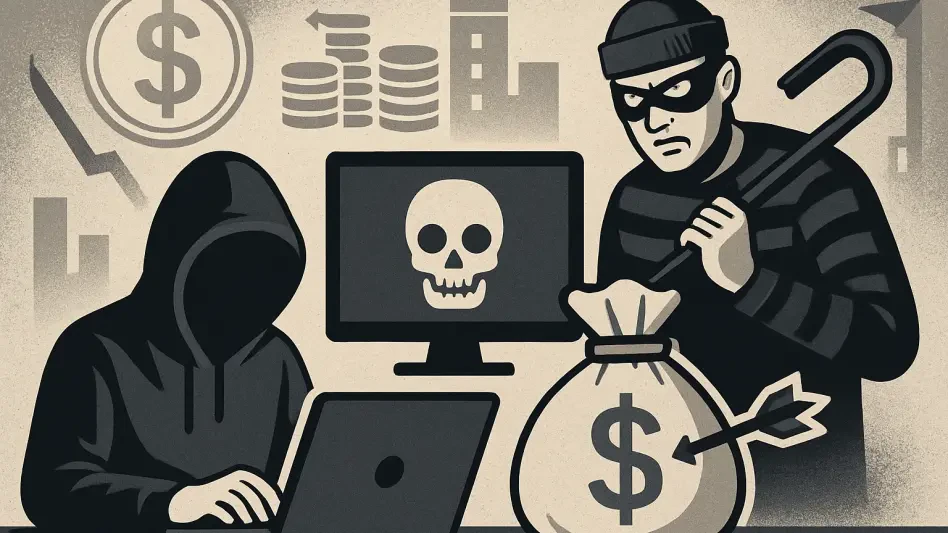In the shadowy corners of the internet, a staggering discovery has emerged: nearly half a million stolen credentials from FTSE 100 companies are circulating on criminal websites, ready to be exploited by cybercriminals. This alarming figure, uncovered by recent investigations, paints a chilling picture of vulnerability among the UK’s most powerful corporations, raising urgent questions about the security of sensitive data, financial systems, and trade secrets already in the wrong hands. This revelation sets the stage for a critical examination of corporate security in an era where digital threats loom larger than ever.
The importance of this issue cannot be overstated, as these compromised credentials represent not just a breach of privacy but a potential gateway to catastrophic financial losses, reputational damage, and regulatory scrutiny. With the UK’s top 100 companies at stake—representing industries from finance to energy—the ripple effects of such vulnerabilities could impact the national economy and investor confidence. This exploration delves into the scale of the problem, the underlying causes, and the urgent steps needed to safeguard these corporate giants from an invisible yet pervasive danger.
A Startling Find in the Depths of the Web
Deep within cybercrime communities, a treasure trove of stolen data has been unearthed, revealing a massive 460,000 compromised credentials tied to FTSE 100 firms. These credentials, ranging from login details to access codes, have been found on both the clear and dark web, exposing a hidden underbelly of digital risk. The sheer volume of this breach signals a systemic issue that even the most prominent organizations struggle to contain.
Financial services, a cornerstone of the UK economy, appear to be hit hardest, with over 70,000 credentials exposed. This sector-specific targeting suggests that cybercriminals are prioritizing high-value industries where the payoff from breaches could be immense. The presence of such data on criminal platforms underscores the ease with which sensitive information can slip through the cracks of corporate defenses.
For some companies, the scale of exposure is staggering, with individual firms reporting up to 45,000 leaked credentials, and 15 organizations surpassing the 10,000 mark. These numbers are not just statistics—they represent real vulnerabilities that could be exploited at any moment. The question remains: how did such a vast breach occur, and what does it mean for the security landscape of these corporate titans?
The Rising Danger of Credential Theft for Major Corporations
Stolen credentials have become a prime currency for cybercriminals, offering direct access to critical systems, proprietary information, and financial assets. In the digital age, the proliferation of infostealer malware has amplified this threat, making it easier than ever for attackers to harvest login details en masse. For FTSE 100 companies, which stand as symbols of corporate strength, this vulnerability poses a unique challenge to their stability and trustworthiness.
The consequences of these breaches extend far beyond immediate data loss. A successful attack using stolen credentials could lead to millions in financial damages, erode customer trust, and invite heavy fines from regulatory bodies. With infostealer malware alone contributing to 28,000 leaked credentials—averaging 280 per company—these incidents highlight a growing trend that demands immediate attention from boardrooms across the nation.
Moreover, the accessibility of compromised data on dark web marketplaces has lowered the barrier for entry, allowing even less sophisticated attackers to purchase ready-made access to corporate networks. This democratization of cybercrime means that FTSE 100 firms are not just battling elite hackers but also opportunistic individuals seeking quick gains. Addressing this multifaceted threat requires a deeper understanding of its origins and scope.
Diving into the Extent and Roots of the Credential Problem
A detailed report titled FTSE 100 for Sale lays bare the alarming extent of credential exposure among the UK’s leading companies. The study reveals that some organizations face up to 45,000 compromised credentials, with a significant portion of firms grappling with leaks in the tens of thousands. Such widespread exposure points to systemic flaws in how digital access is managed and protected across these enterprises.
Delving into the causes, the report identifies infostealer malware as a key culprit, with thousands of credentials traced back to these malicious tools. Beyond malware, poor password practices exacerbate the issue—59% of companies have employees using “password” as their actual password, while reuse of weak variants, such as names of public figures, is distressingly common. These basic lapses in security hygiene create easy entry points for attackers.
Perhaps most concerning is the discovery of high-level credentials, including those of CXO executives, on notorious dark web platforms. This targeting of senior personnel indicates a strategic approach by cybercriminals, aiming for access that could unlock entire systems or sensitive decision-making data. The combination of technical and human vulnerabilities paints a troubling picture of the current state of corporate cybersecurity.
Cybercrime’s Opportunistic Edge: Expert Perspectives
Insights from industry specialists shed light on the pragmatic mindset driving cybercrime today. Anne Heim, a threat intelligence expert, notes that attackers often bypass complex hacking efforts when they can simply purchase stolen credentials online. This opportunistic approach highlights how the availability of compromised data on criminal marketplaces has transformed the threat landscape, making breaches more frequent and less resource-intensive for perpetrators.
The true scale of the problem may be far greater than reported figures suggest. Experts warn that the 460,000 known credentials could represent only a fraction of the total exposure, with many more potentially in active use or hidden in obscure channels. This uncertainty adds a layer of urgency to the need for companies to shift from a reactive stance to a proactive defense strategy.
Such expert analysis emphasizes that waiting for an attack to occur is no longer a viable option. The ease with which cybercriminals can exploit stolen data demands that organizations anticipate and neutralize threats before they materialize. This mindset shift is crucial for FTSE 100 companies aiming to protect their assets in an increasingly hostile digital environment.
Practical Measures to Protect Corporate Powerhouses
To counter the escalating risk of credential theft, FTSE 100 companies must adopt a comprehensive, multi-layered security framework. Recommendations from recent studies provide a clear roadmap, starting with enforcing robust password policies aligned with national cybersecurity guidelines. Encouraging the use of password managers and educating employees on secure practices can significantly reduce human error as a point of failure.
Beyond passwords, implementing phishing-resistant multi-factor authentication (MFA) and passkeys across all devices and services adds a critical barrier against unauthorized access. Conditional access policies, which evaluate factors like device compliance and user risk before granting entry, further tighten security. Additionally, proactive monitoring for leaked credentials on the dark web, coupled with swift password resets for compromised accounts, can help mitigate damage before it escalates.
Other vital steps include establishing strict Bring Your Own Device (BYOD) policies that mandate MFA for corporate access and deploying detection tools to flag suspicious behavior, such as unusual logins or malware activity. These actionable strategies collectively form a robust defense mechanism, empowering companies to safeguard their digital assets. By prioritizing these measures, corporate leaders can transform vulnerability into resilience, ensuring that stolen credentials do not become the downfall of their organizations.
Reflecting on a Path Forward
Looking back, the journey through the dark underbelly of credential theft revealed a stark reality for FTSE 100 companies, where nearly half a million stolen logins stood as a silent threat to their stability. Each statistic and expert warning uncovered painted a picture of urgency, demanding a reevaluation of how digital security is approached at the highest levels of business. The scale of exposure, coupled with human and technical vulnerabilities, served as a sobering reminder of the stakes involved.
As the dust settled on this alarming discovery, attention turned toward actionable solutions that could fortify these corporate giants against future breaches. Strengthening password practices, embracing advanced authentication methods, and maintaining vigilant monitoring emerged as cornerstones of a new security ethos. These steps, if implemented with commitment, promised to shift the balance away from opportunistic cybercriminals.
Ultimately, the path forward rested on a collective resolve to prioritize cybersecurity as a core pillar of corporate strategy. By investing in innovative tools and fostering a culture of awareness, companies could build a future where stolen credentials no longer held the power to unravel their foundations. This commitment to vigilance and adaptation stood as the most enduring lesson from a crisis that shook the very core of the UK’s business landscape.








